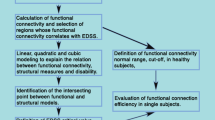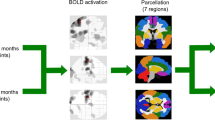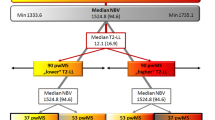Abstract
Purpose
In multiple sclerosis (MS), how brain functional changes relate to clinical conditions is still a matter of debate. The aim of this study was to investigate how functional connectivity (FC) reorganization at three different scales, ranging from local to whole brain, is related to tissue damage and disability.
Methods
One-hundred-nineteen patients with MS were clinically evaluated with the Expanded Disability Status Scale and the Multiple Sclerosis Functional Composite. Patients and 42 healthy controls underwent a multimodal 3 T MRI, including resting-state functional MRI.
Results
We identified 16 resting-state networks via independent component analysis and measured within-network, between-network, and whole-brain (global efficiency and degree centrality) FC. Within-network FC was higher in patients than in controls in default mode, frontoparietal, and executive-control networks, and corresponded to low clinical impairment (default mode network versus Expanded Disability Status Scale r = − 0.31, p < 0.01; right frontoparietal network versus Paced Auditory Serial Addition Test r = 0.33, p < 0.01). All measures of between-network and whole-brain FC, except default mode network global efficiency, were lower in patients than in controls, and corresponded to high disability (i.e., basal ganglia global efficiency versus Timed 25-Foot Walk r = − 0.25, p < 0.03; default mode global efficiency versus Expanded Disability Status Scale r = − 0.44, p < 0.001). Altered measures of within-network, between-network, and whole-brain FC were combined in functional indices that were linearly related to disease duration, Paced Auditory Serial Addition Test and lesion load and non-linearly related to Expanded Disability Status Scale.
Conclusion
We suggest that the combined evaluation of functional alterations occurring at different levels, from local to whole brain, could exhaustively describe neuroplastic changes in MS, while increased within-network FC likely represents adaptive compensatory processes, decreased between-network and whole-brain FC likely represent loss of functional network integration consequent to structural disruption.





Similar content being viewed by others
References
Zatorre RJ, Fields RD, Johansen-Berg H (2012) Plasticity in gray and white: neuroimaging changes in brain structure during learning. Nat Neurosci 15:528–536. https://doi.org/10.1038/nn.3045
De Giglio L, Tommasin S, Petsas N, Pantano P (2018) The role of fMRI in the assessment of neuroplasticity in MS: a systematic review. In: Neural Plasticity. https://www.hindawi.com/journals/np/2018/3419871/. Accessed 1 Jan 2019
Pantano P, Iannetti GD, Caramia F, Mainero C, di Legge S, Bozzao L, Pozzilli C, Lenzi GL (2002) Cortical motor reorganization after a single clinical attack of multiple sclerosis. Brain 125:1607–1615
Roosendaal SD, Schoonheim MM, Hulst HE, Sanz-Arigita EJ, Smith SM, Geurts JJ, Barkhof F (2010) Resting state networks change in clinically isolated syndrome. Brain 133:1612–1621. https://doi.org/10.1093/brain/awq058
Rocca MA, Valsasina P, Leavitt VM, Rodegher M, Radaelli M, Riccitelli GC, Martinelli V, Martinelli-Boneschi F, Falini A, Comi G, Filippi M (2018) Functional network connectivity abnormalities in multiple sclerosis: correlations with disability and cognitive impairment. Mult Scler 24:459–471. https://doi.org/10.1177/1352458517699875
Penner I-K, Aktas O (2017) Functional reorganization is a maladaptive response to injury - NO. Mult Scler 23:193–194. https://doi.org/10.1177/1352458516679895
Rocca MA, Meani A, Riccitelli GC, Colombo B, Rodegher M, Falini A, Comi G, Filippi M (2016) Abnormal adaptation over time of motor network recruitment in multiple sclerosis patients with fatigue. Mult Scler 22:1144–1153. https://doi.org/10.1177/1352458515614407
Tona F, Petsas N, Sbardella E et al (2014) Multiple sclerosis: altered thalamic resting-state functional connectivity and its effect on cognitive function. Radiology:131688. https://doi.org/10.1148/radiol.14131688
Rocca MA, Valsasina P, Absinta M et al (2014) Intranetwork and internetwork functional connectivity abnormalities in pediatric multiple sclerosis. Hum Brain Mapp 35:4180–4192. https://doi.org/10.1002/hbm.22469
Eijlers AJC, Meijer KA, Wassenaar TM, Steenwijk MD, Uitdehaag BM, Barkhof F, Wink AM, Geurts JJ, Schoonheim MM (2017) Increased default-mode network centrality in cognitively impaired multiple sclerosis patients. Neurology 88:952–960. https://doi.org/10.1212/WNL.0000000000003689
Meijer KA, Eijlers AJC, Douw L, Uitdehaag BMJ, Barkhof F, Geurts JJG, Schoonheim MM (2017) Increased connectivity of hub networks and cognitive impairment in multiple sclerosis. Neurology 88:2107–2114. https://doi.org/10.1212/WNL.0000000000003982
Meijer KA, Eijlers AJC, Geurts JJG, Schoonheim MM (2018) Staging of cortical and deep grey matter functional connectivity changes in multiple sclerosis. J Neurol Neurosurg Psychiatry 89:205–210. https://doi.org/10.1136/jnnp-2017-316329
van den Heuvel MP, Hulshoff Pol HE (2010) Exploring the brain network: a review on resting-state fMRI functional connectivity. Eur Neuropsychopharmacol 20:519–534. https://doi.org/10.1016/j.euroneuro.2010.03.008
Polman CH, Reingold SC, Banwell B, Clanet M, Cohen JA, Filippi M, Fujihara K, Havrdova E, Hutchinson M, Kappos L, Lublin FD, Montalban X, O'Connor P, Sandberg-Wollheim M, Thompson AJ, Waubant E, Weinshenker B, Wolinsky JS (2011) Diagnostic criteria for multiple sclerosis: 2010 revisions to the McDonald criteria. Ann Neurol 69:292–302. https://doi.org/10.1002/ana.22366
Kurtzke JF (1983) Rating neurologic impairment in multiple sclerosis: an expanded disability status scale (EDSS). Neurology 33:1444–1452. https://doi.org/10.1212/wnl.33.11.1444
Fischer JS, Rudick RA, Cutter GR, Reingold SC (1999) The multiple sclerosis functional composite measure (MSFC): an integrated approach to MS clinical outcome assessment. National MS Society clinical outcomes assessment task force. Mult Scler 5:244–250. https://doi.org/10.1177/135245859900500409
Tommasin S, De Giglio L, Ruggieri S et al (2018) Relation between functional connectivity and disability in multiple sclerosis: a non-linear model. J Neurol 265:2881–2892. https://doi.org/10.1007/s00415-018-9075-5
Smith SM (2002) Fast robust automated brain extraction. Hum Brain Mapp 17:143–155. https://doi.org/10.1002/hbm.10062
Smith SM, De Stefano N, Jenkinson M, Matthews PM (2001) Normalized accurate measurement of longitudinal brain change. J Comput Assist Tomogr 25:466–475
Andersson JLR, Sotiropoulos SN (2016) An integrated approach to correction for off-resonance effects and subject movement in diffusion MR imaging. Neuroimage 125:1063–1078. https://doi.org/10.1016/j.neuroimage.2015.10.019
Smith SM, Jenkinson M, Johansen-Berg H, Rueckert D, Nichols TE, Mackay CE, Watkins KE, Ciccarelli O, Cader MZ, Matthews PM, Behrens TE (2006) Tract-based spatial statistics: voxelwise analysis of multi-subject diffusion data. Neuroimage 31:1487–1505. https://doi.org/10.1016/j.neuroimage.2006.02.024
Jenkinson M, Bannister P, Brady M, Smith S (2002) Improved optimization for the robust and accurate linear registration and motion correction of brain images. Neuroimage 17:825–841
Pruim RHR, Mennes M, van Rooij D et al (2015) ICA-AROMA: a robust ICA-based strategy for removing motion artifacts from fMRI data. Neuroimage 112:267–277. https://doi.org/10.1016/j.neuroimage.2015.02.064
Beckmann CF, DeLuca M, Devlin JT, Smith SM (2005) Investigations into resting-state connectivity using independent component analysis. Philos Trans R Soc B Biol Sci 360:1001–1013. https://doi.org/10.1098/rstb.2005.1634
Beckmann C, Mackay C, Filippini N, Smith S (2009) Group comparison of resting-state FMRI data using multi-subject ICA and dual regression. NeuroImage 47:S148. https://doi.org/10.1016/S1053-8119(09)71511-3
Benjamini Y, Hochberg Y (1995) Controlling the false discovery rate: a practical and powerful approach to multiple testing. J R Stat Soc Ser B Methodol 57:289–300
Sporns O (2013) Network attributes for segregation and integration in the human brain. Curr Opin Neurobiol 23:162–171. https://doi.org/10.1016/j.conb.2012.11.015
Tononi G, Sporns O, Edelman GM (1994) A measure for brain complexity: relating functional segregation and integration in the nervous system. Proc Natl Acad Sci U S A 91:5033–5037
Friston K (2002) Functional integration and inference in the brain. Prog Neurobiol 68:113–143
Bisecco A, Nardo FD, Docimo R et al (2017) Fatigue in multiple sclerosis: the contribution of resting-state functional connectivity reorganization. Mult Scler J 135245851773093. https://doi.org/10.1177/1352458517730932
Faivre A, Rico A, Zaaraoui W, Crespy L, Reuter F, Wybrecht D, Soulier E, Malikova I, Confort-Gouny S, Cozzone PJ, Pelletier J, Ranjeva JP, Audoin B (2012) Assessing brain connectivity at rest is clinically relevant in early multiple sclerosis. Mult Scler 18:1251–1258. https://doi.org/10.1177/1352458511435930
Sacco R, Bonavita S, Esposito F et al (2013) The contribution of resting state networks to the study of cortical reorganization in MS. Mult Scler Int 2013. https://doi.org/10.1155/2013/857807
van Geest Q, Douw L, van ‘t Klooster S et al (2018) Information processing speed in multiple sclerosis: relevance of default mode network dynamics. Neuroimage Clin 19:507–515. https://doi.org/10.1016/j.nicl.2018.05.015
Li K, Luo X, Zeng Q, Huang P, Shen Z, Xu X, Xu J, Wang C, Zhou J, Zhang M, Alzheimer’s Disease Neuroimaging Initiative (2019) Gray matter structural covariance networks changes along the Alzheimer’s disease continuum. Neuroimage Clin 23:101828. https://doi.org/10.1016/j.nicl.2019.101828
Zhao Q, Sang X, Metmer H, Swati ZNNK, Lu J, Alzheimer’s Disease NeuroImaging Initiative (2019) Functional segregation of executive control network and frontoparietal network in Alzheimer’s disease. Cortex 120:36–48. https://doi.org/10.1016/j.cortex.2019.04.026
Dosenbach NUF, Visscher KM, Palmer ED, Miezin FM, Wenger KK, Kang HC, Burgund ED, Grimes AL, Schlaggar BL, Petersen SE (2006) A core system for the implementation of task sets. Neuron 50:799–812. https://doi.org/10.1016/j.neuron.2006.04.031
Weier K, Banwell B, Cerasa A, Collins DL, Dogonowski AM, Lassmann H, Quattrone A, Sahraian MA, Siebner HR, Sprenger T (2015) The role of the cerebellum in multiple sclerosis. Cerebellum 14:364–374. https://doi.org/10.1007/s12311-014-0634-8
d’Ambrosio A, Valsasina P, Gallo A et al (2019) Reduced dynamics of functional connectivity and cognitive impairment in multiple sclerosis. Mult Scler:1352458519837707. https://doi.org/10.1177/1352458519837707
Lin S-J, Vavasour I, Kosaka B, Li DKB, Traboulsee A, MacKay A, McKeown M (2018) Education, and the balance between dynamic and stationary functional connectivity jointly support executive functions in relapsing-remitting multiple sclerosis. Hum Brain Mapp 39:5039–5049. https://doi.org/10.1002/hbm.24343
Sporns O (2013) Structure and function of complex brain networks. Dialogues Clin Neurosci 15:247–262
Dogonowski A-M, Andersen KW, Madsen KH, Sørensen PS, Paulson OB, Blinkenberg M, Siebner HR (2014) Multiple sclerosis impairs regional functional connectivity in the cerebellum. Neuroimage Clin 4:130–138. https://doi.org/10.1016/j.nicl.2013.11.005
Louapre C, Perlbarg V, García-Lorenzo D, Urbanski M, Benali H, Assouad R, Galanaud D, Freeman L, Bodini B, Papeix C, Tourbah A, Lubetzki C, Lehéricy S, Stankoff B (2014) Brain networks disconnection in early multiple sclerosis cognitive deficits: an anatomofunctional study: disconnection and cognition in MS. Hum Brain Mapp 35:4706–4717. https://doi.org/10.1002/hbm.22505
Rocca MA, Valsasina P, Meani A, Falini A, Comi G, Filippi M (2016) Impaired functional integration in multiple sclerosis: a graph theory study. Brain Struct Funct 221:115–131. https://doi.org/10.1007/s00429-014-0896-4
Zhou F, Zhuang Y, Gong H, Wang B, Wang X, Chen Q, Wu L, Wan H (2014) Altered inter-subregion connectivity of the default mode network in relapsing remitting multiple sclerosis: a functional and structural connectivity study. PLoS One 9:e101198. https://doi.org/10.1371/journal.pone.0101198
Schoonheim MM, Meijer KA, Geurts JJG (2015) Network collapse and cognitive impairment in multiple sclerosis. Front Neurol 6:82. https://doi.org/10.3389/fneur.2015.00082
Liu Y, Liang P, Duan Y, Huang J, Ren Z, Jia X, Dong H, Ye J, Shi FD, Butzkueven H, Li K (2015) Altered thalamic functional connectivity in multiple sclerosis. Eur J Radiol 84:703–708. https://doi.org/10.1016/j.ejrad.2015.01.001
Sbardella E, Upadhyay N, Tona F et al (2017) Dentate nucleus connectivity in adult patients with multiple sclerosis: functional changes at rest and correlation with clinical features. Mult Scler 23:546–555. https://doi.org/10.1177/1352458516657438
Funding
This study was partially supported by the Italian Foundation of multiple sclerosis (FISM), grant number 2018/S/3.
Author information
Authors and Affiliations
Corresponding author
Ethics declarations
Conflict of interest
ST and CG declare no conflict of interest. LDG received speaking honoraria from Genzyme and Novartis; travel grants from Biogen, Merk, and Teva; and consulting fees from Genzyme, Merk, and Novartis. SR received fees as speaking honoraria from Teva, Merck Serono, and Biogen; travel grants from Biogen and Merck Serono; and fees as advisory board consultant from Merck Serono and Novartis. NP received speaker fees from Biogen and mission support from Genzyme and Novartis. CP received consulting and lecture fees and research funding and travel grants from Almirall, Bayer, Biogen, Genzyme, Merck Serono, Novartis, Roche, and Teva. PP received founding for travel from Novartis, Genzyme, Bracco, and Biogen.
Ethical approval
All procedures performed in the studies involving human participants were in accordance with the ethical standards of the institutional and/or national research committee and with the 1964 Helsinki Declaration and its later amendments or comparable ethical standards.
Informed consent
Informed consent was obtained from all individual participants included in the study.
Additional information
Publisher’s note
Springer Nature remains neutral with regard to jurisdictional claims in published maps and institutional affiliations.
Rights and permissions
About this article
Cite this article
Tommasin, S., De Giglio, L., Ruggieri, S. et al. Multi-scale resting state functional reorganization in response to multiple sclerosis damage. Neuroradiology 62, 693–704 (2020). https://doi.org/10.1007/s00234-020-02393-0
Received:
Accepted:
Published:
Issue Date:
DOI: https://doi.org/10.1007/s00234-020-02393-0




